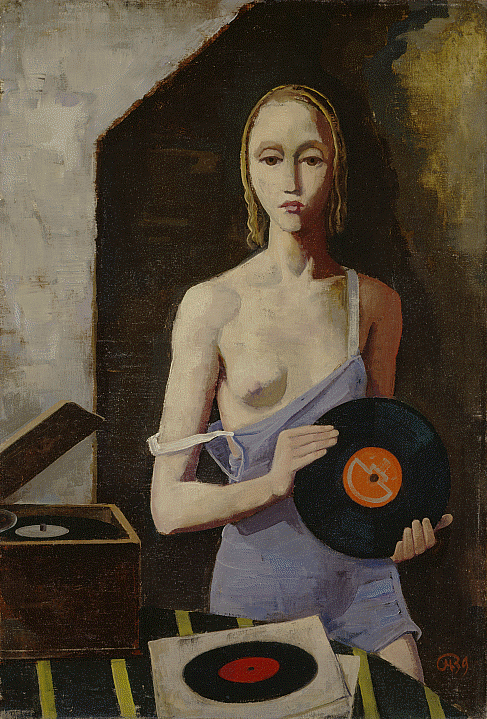One of my worst fears is being forgotten. I think there are books written about such things. I’ve not read them yet. I know there is depth to this that outside ears and psychological study could support.
But I am starting to realize that this fear is the very reason I desperately cling to objects. I’m known by those closest to me as an incredibly sentimental person. I save so, so many things. They have natural permanence that I don’t have, not in the same way.
And I even reclaim things and places. If there is a place I’ve been that causes pain, I go back and redo the moment, make it new. I reclaim it.
This painting was one of those objects. When I was in middle school my dad and I took a guided tour of the Nelson Atkins Museum of Art in Kansas City with a group of art enthusiasts that we didn’t know. Long story, but normal for us.
We turned a corner on our guided tour and she happened to be hanging behind a short sidewall. I know now that even calling her “her” reveals how intimate it felt- to a painting. To an idea.
The painting is of a young woman in an attic next to an open window and dressed in a strapped undergarment that has fallen off her shoulder and exposed her right breast. She is holding a vinyl record and is in the act of either placing it on a record player or just browsing. The girl is looking directly at us, knowing we are there.
There’s no visible window and I’m just assuming she’s in an attic. My head can’t quite separate that particular version from the actual image. I just decided to fill in what wasn’t there. Classic me.
It seems there are two versions of this painting. They are quite different emotionally. It is unknown when the second was painted.
No one in the group was really impressed by it. They thought the painting was bland, dark or washed out, not a lot behind the eyes. But some thought it was charming, and cute.
I got angry. They don’t know her. They can’t see. Of course they can’t see, they are blind. But the desperately lonely young woman viewing her that day saw a desperately lonely young woman staring back at her.
Trembling, I spoke up. “She looks like she’s been used. Tired. Like she’s just come out of the rain or something. Like she’s been hurt. Like we aren’t supposed to see this.”
There were pauses and murmurs of interest and then the group moved on. I did not.
15 years later I googled the artist. I’d never once considered who’d painted it or why. Perhaps my own recent art-making made me hungry for connection to any like-minded soul. I found myself wanting to find a kindred spirit in the artist whose work had affected me so deeply.
Yeah, it didn’t go that way. Well, not in the way I’d expected.
‘The Record Player” was painted in 1939 by German expressionist Karl Hofer. He had become a prominent member of the German art community by the time this painting was created, and he had begun to teach at a respected German art school. He was outspoken against Hitler from the beginning, but also desperately wanted to remain in the good graces of not only the art world, but more importantly to his native Germany. He wanted to be known as a patriot artist.
His wife, Mathilde Scheinberger, was born to a non-practicing Jewish family. She later became a Protestant, and was one when they got married. Karl and Mathilde had three children together. They spent much of their marriage in his art success. Eventually they separated but did not divorce.
Hofer was becoming more and more popular and his work was being noticed. And he was being noticed. A Nazi propaganda poster proclaimed Hofer a Jew because his wife was Jewish. He adamantly denied it, saying he and his art were “Free of Jews”. In 1937, Soon after the poster incident, over 300 of Hofer’s works were confiscated by the Third Reich and then put on display during their “Degenerate Art” exhibition. In 1938 he lost his teaching position and was banned from selling art in Germany.
I’m going to copy the rest of my research, verbatim, to just get to it.
“In an attempt to maintain his career as a German citizen, he formally divorced Mathilde and married a woman whose background qualified her as of “aryan” descent, effectively lifting the ban. Mathilde, no longer protected under the “mixed marriage” laws instated by the Nazi regime, was sent in 1939 to the Auschwitz concentration camp, where she died in 1942.”
Hofer painted “The Record Player” in 1939.
“In March of 1943 his Berlin studio was bombed, destroying all of the work he had created upon his reinstatment into the German art world, and in November his apartment was also destroyed.”
“Once the war was over, Hofer became instrumental in creating the Berlin Academy of Arts and in promoting the work of German artists. By the time of his death of a stroke in 1955, he had recieved an honorary doctorate from the University of Berlin in 1948, and was awarded the Order Pour le mérite for Science and Arts in 1952 and the Great Cross of the Order of Merit of the Federal Republic of Germany in 1953.” (Annex Galleries)
I don’t see myself anymore when I look at “The Record Player”. I just see her. Mathilde.
Did he know? Did he know what would happen to her? It’s a tragedy if he found out later. It’s a travesty if he knew and kept going. Did he know?
Karl Hoffer is remembered as an influential modern German artist. He got what he wanted.
What was this all for? What in the hell was this painting saying?
I cling to objects because I don’t want to be forgotten. Knowing the object’s story makes the object a ghost. If I can connect to it, then maybe I won’t become a ghost myself. If I honor the hand that created it or the hand that held it, maybe my hand will be felt too.
But this? How can I honor this? When there was her? At the end of his life, was Karl Hofer proud? Or was he just trying not to become a ghost?
What am I capable of if I become desperate enough to not be forgotten?
What do her eyes say?
Reference Material:
Nelson Atkins Museum of Art- https://art.nelson-atkins.org/objects/16655/the-record-player
The Annex Galleries- https://www.annexgalleries.com/artists/biography/4142/Hofer/Karl
https://smartify.org/artworks/karl-hofer-the-record-player
https://amycrehore.blogspot.com/2014/07/painter-karl-hofers-record-player-1939.html
Karl Hofer portfolio: http://www.artnet.com/artists/karl-hofer/
Karl Hofer biography: https://en.wikipedia.org/wiki/Karl_Hofer
Mathilde Hofer biography: https://de.wikipedia.org/wiki/Mathilde_Hofer (German)

